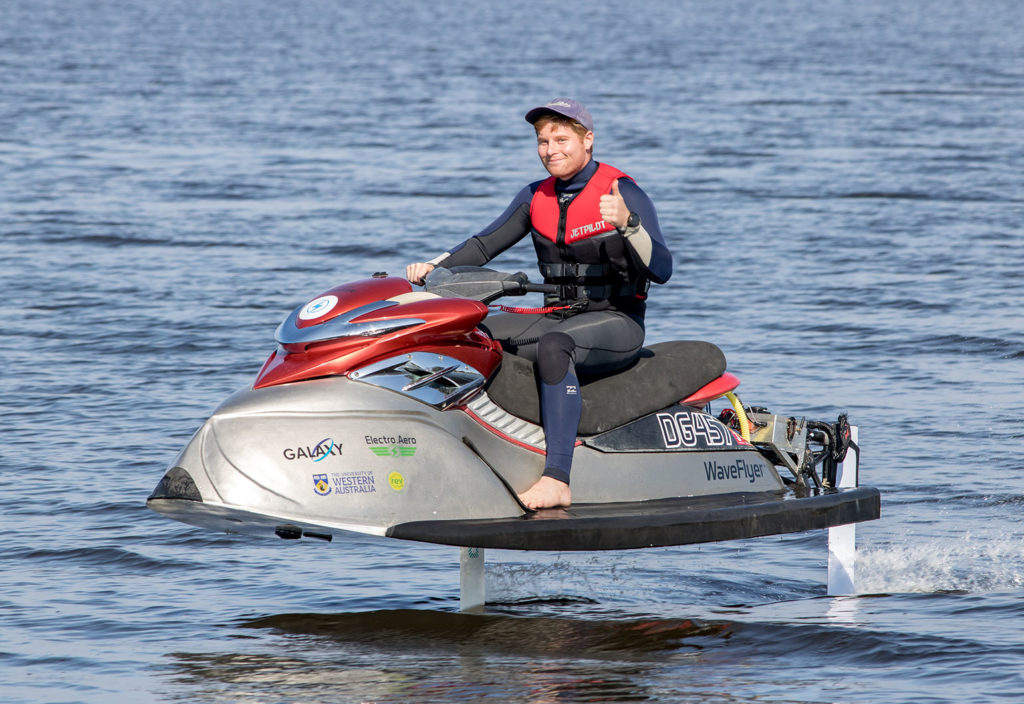Fumes and roaring engines have led to jet skis being banished from many waterways. A Western Australian company has developed a battery-powered flying watercraft that could take their place.
The idea for Electro.Aero’s WaveFlyer electric water vehicle was born after co-founder and mechatronic engineer Josh Portlock was approached by the renewable energy vehicles (REV) program at the University of Western Australia to help design an electric watercraft.
REV had already retrofitted a conventional jet ski with electrical components, but wanted to start again from scratch to achieve greater endurance and range. They asked Portlock to apply his aerodynamics and electric propulsion expertise to the task.
Portlock came up with the idea of designing a hydrofoil that people could ride like a jet ski while flying above the water’s surface.
“Hydrofoils are basically underwater aircraft, which is right up my alley,” Portlock told create.
When jet ski meets hydrofoil
Portlock explained that WaveFlyer’s twin hydrofoil design has about one quarter of the hull drag of a conventional jet ski, which significantly reduces the power consumption.
“It ends up being about four times more efficient on an electric hydrofoil propulsion system than a conventional [electric] jet ski,” he added.
This means that for the same endurance as a conventional electric jet ski, WaveFlyer can have a battery one-quarter of the size, making it cheaper and lighter.
While Portlock is keeping the detailed specs of the WaveFlyer under wraps, he told create that its propulsion system includes electric thrusters mounted on the hydrofoil. The vessel also uses an electronically activated stability control system to keep the craft level, which makes for a smoother ride than the polyhedral angled foils used to stabilise other hydrofoil craft.
The WaveFlyer prototype can run for 30 minutes on a single charge of its 2 kWh lithium-ion battery, with the potential to increase endurance by adding extra battery storage. The prototype’s maximum speed is 40 km/h. Portlock said his team has plans to achieve higher speeds in future iterations of the design, but the current performance still made for a satisfying experience.
“Even 25 to 30 km/h feels very fast when you’re flying half a metre above the water,” he explained, adding that while conventional jet skis are speedier, the WaveFlyer is aiming for efficiency.
WaveFlyer also has a high lift to weight ratio, with the ability to carry two full grown adults while weighing less than one.
Portlock said the greatest challenge in developing the WaveFlyer was keeping on top of the compromises between electrical, mechanical and hydrodynamic disciplines to create an optimised and integrated solution.
“It’s very multidisciplinary. You’re constantly having to trade off one thing for another, and it’s not easy to do,” he added.
Flying start on the market
This isn’t the first time Portlock has created a prototype that blurs traditional boundaries. In 2016, he was part of a collaboration that developed the FlyKart, a hovering single-seater go-cart.
The FlyKart was a proof-of-concept prototype. But with the WaveFlyer, Portlock plans to disrupt the personal recreational water vehicle market by promoting it as an alternative in places where jet skis have been banned, particularly ecotourism destinations.
Portlock is in discussions with investors to raise the necessary capital to scale up production, and hopes to have commercial models available in the next six to 12 months. In the next five years, Portlock said his WaveDrive technology could be used to power other vessels including water taxis.
“When you start getting into bigger craft and scaling up our tech there’s quite a lucrative disruption opportunity … it’s a real game-changer for electrifying different watercraft,” he said, adding that he was keen to get into the market quickly and seize the opportunity.
Innovating with a purpose
Portlock founded Electro.Aero five years ago with a view to scaling up drone technology to carry passengers – which led to the FlyKart prototype.
But regulations were an obstacle to taking the FlyKart concept further, so Portlock joined forces with his business-minded co-founder Richard Charlton to purchase and register the world’s first licenced electric light sport aircraft and set up a training school as a first step towards electrifying the Rottnest Island Air Taxi Service.
While Portlock sees an immediate opportunity to launch WaveFlyer into the water vehicle market, he believes his company’s long-term prospects are in electric aviation. To this end, he is laying the groundwork to make Electro.Aero the “go-to” company for electric propulsion as the commercial landscape evolves.
Portlock encouraged other engineers interested in entrepreneurship to innovate with a purpose and try to make a difference by commercialising their technology, rather than designing something new for the cool-factor.
“You have to have that right balance of commercialisation and innovation,” he said.
